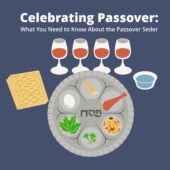Celebrating Passover: What You Need to Know About the Passover Seder
As the Jewish college student organization Hillel International explains on hillel.org, “Passover is the most celebrated Jewish holiday throughout the world, commemorating the Israelites’ exodus from a life of slavery in Egypt to freedom. On the first two nights of Passover, many Jews hold a seder (literally ‘order’), consisting of a series of readings and rituals, and we retell the Passover story. The seder is an annual Jewish ritual in which groups of people—families, friends, communities, and even groups of strangers—gather for a time of reflective conversation about freedom.”
The seder encompasses 15 steps laid out plainly in the Haggadah, the text read during the ceremonial meal.
Despite the seeming meticulousness of the steps, within the text modern Jews find room for improvisation, discussion and adaptation. And though the ritual varies by both geography and time period, themes of freedom, gratitude and faith permeate.
MODERN OFFERING
T.K. Stark, a 30-year-old Jew living in Salt Lake City, UT, says his experience with the seder may be different from the more Orthodox interpretations, but the focus and feelings it evokes are universal.
While they follow the order of the seder he says they modify it a little. “We have a shorter version,” he laughs.
This sort of personalization is built into the structure of the Haggadah, says Josh Lipman, in his last year of college at the University of Utah. “Every traditional seder has its own spin.” The point isn’t just to follow the rote steps but to “use the Haggadah as a basis for conversation. Following it is in essence to stray from it,“ he adds.
Despite alterations, the emphasis remains the same: the deliverance of the Israelite slaves and its modern day parallels. These parallels can be made with broad strokes, “really anywhere that you feel or someone at the table feels empowered to start a conversation,” Lipman says.
Stark has participated in seder discussions ranging from overcoming personal bondage to societal issues like human trafficking.
For Lipman, the adaptability of the text helps bolster his belief. “The seder in many ways encapsulates what Judaism is about—in critical thinking and asking hard questions and not necessarily finding the answer. And for me that’s really important.”
The ritual as found in the Haggadah goes back centuries, but the seder as followed in Biblical times varied in marked ways, all centered around the historical Jews’ most sacred space.
HISTORICAL PRACTICE
Were you to find yourself roaming the streets of Jerusalem on the first day of Passover around the first century C.E., you may be drawn in with crowds pushing towards the centerpiece of city and faith—the temple. Faithful Jews from all across Israel streamed into the Holy City carrying an unblemished lamb to offer God. The sacrificial offerings were slaughtered en masse by priests and lay Jews alike in the Outer Alter while men and women gathered in the grand courtyard to worship and celebrate amidst joyful sounds of prayer and song. The whole city was alight with a “feeling of sacred joy,” says Maeera Shreiber, Chair of the Cross Cultural Jewish Studies Initiative at the University of Utah.
Only after the completion of the main festival were the offerings taken to homes and smaller communities. You’d still find matzot (unleavened bread) and bitter herbs and hear of the miracles of the deliverance from Egypt, you’d still sip wine and munch on the sacrificial lamb and avoid leavened bread, but it would not follow the stricter rigors or full symbolism of the modern worship.
The change has its roots in 70 C.E. After a rebellion and a lengthy siege, Jews watched as Roman legions set their priceless temple ablaze and dismantled it brick by brick. “A lot of what happened in Judaism is trauma of the loss of the temple,” Shreiber says. ”The big question is how are we going to go forward in the wake of this loss that was the pulse of our identity?” Some might have guessed it would have shattered the religion, but the Jews adapted. The rabbis shifted the focus away from temple ritual and over the next centuries worked to formalize belief, tradition and symbology, including writing scripts like those found in the Haggadah.
The modern seder may not take place in a holy temple, but it has been adapted and expanded to, as Shreiber says, “make it a lived experience.”
Seder2015.org: Passover recipes from some of our favorite chefs





